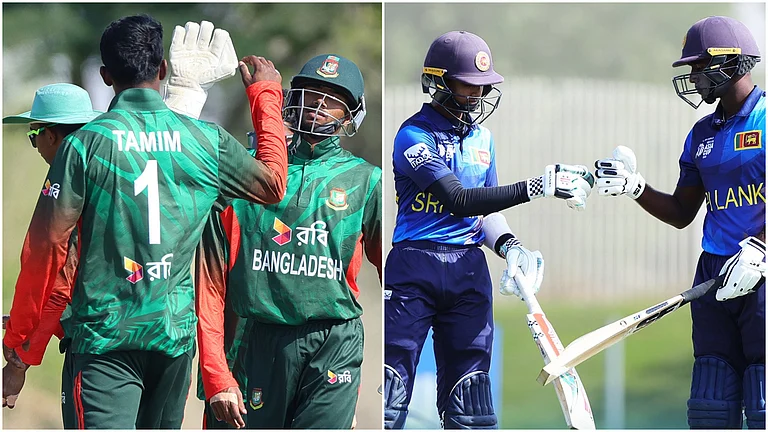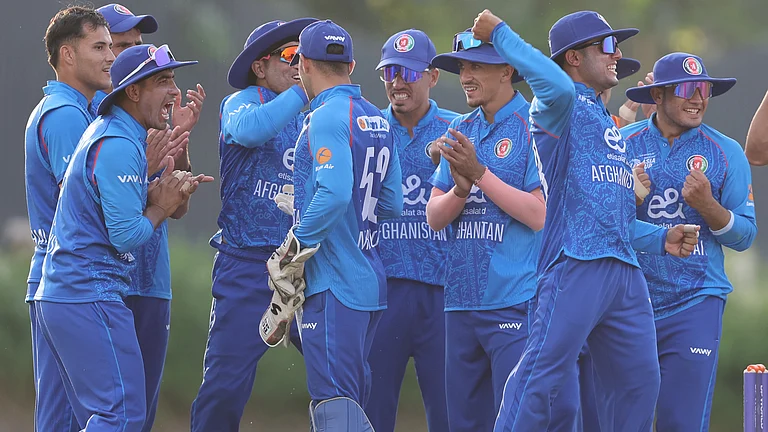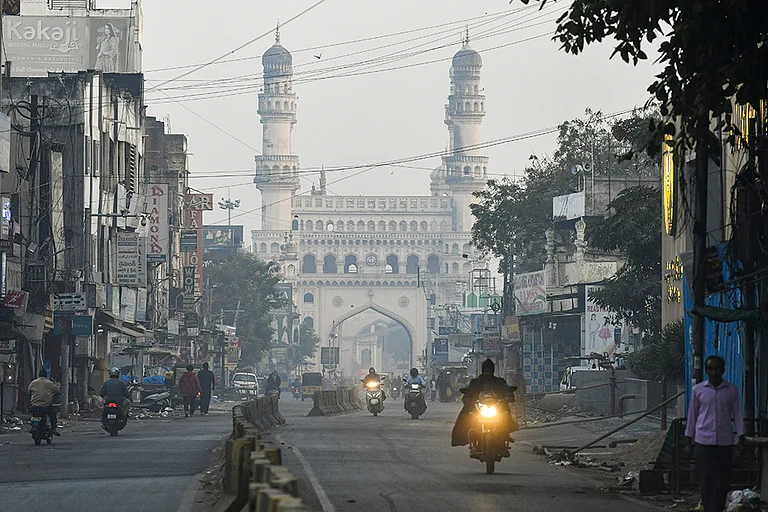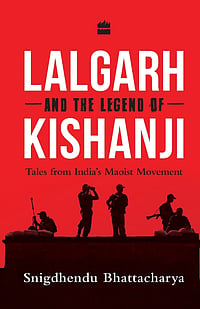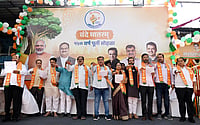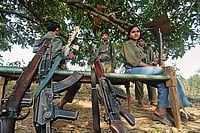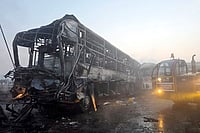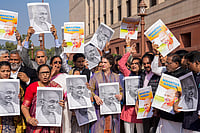Here’s the mother of all conundrums—all the mighty rivers described in the Vedas—the Indus (Sindhu), Jhelum (Vitasta), Chenab (Askini), Ravi (Purushni), Beas (Vipasa) and Sutlej (Shatadru)—exist. Except Saraswati—described as “ambitame, naditame, devitame (the best of mothers, the best of rivers, the best of goddesses)” in the Vedas. How a snow-fed perennial watercourse could completely vanish, leaving no trace detectable by modern science, has triggered interest and debate for over a century-and-a-half.
But, what was a pursuit for precise knowledge of the past in the late 19th and early 20th centuries, turned into a heated political debate in independent India, ever since archeologist Braj Basi Lal introduced the trend of excavating sites approximating descriptions in the ancient Hindu epics, instead of those noted by ancient travellers, which used to be the established mode of enquiry earlier. The project was called ‘Archaeology of Mahabharata Sites’.
As early as in 1964, citing the discovery of Harappan sites far away from the Indus, especially the one at Alamgirpur in UP, Lal had argued that Harappan sites on the Indian side of the border were not dependent on the Indus, hence India should consider changing the nomenclature of the Indus Valley Civilisation (IVC). Prime Minister Lal Bahadur Shastri even wrote the foreword to a book of his. Lal would later be known more for his Ayodhya excavations to find a temple under the Babri Masjid, a report he published in 1990 in the RSS magazine Manthan instead of a peer-reviewed archaeological journal.

One of the earliest urban civilisations in the world, IVC is a contemporary of ancient Egypt and Mesopotamia, but its geographical expanse was greater than the two combined. The IVC is alternately called the Harappan civilisation. The first name refers to the river valley along which it is believed to have thrived, most of which is now in Pakistan. The second refers to the first archaeological site discovered, which is also in Pakistan. This is where the crux of the problem appears to lie—the Partition has circumcised the geographical area within which Hindu nationalists can effectively seek an origin story.
This is why the question of tracing the Vedic Saraswati began animating Hindutva-influenced archaeologists and geologists for the next few decades. Establishing the existence of the mythical Saraswati would help them rename IVC as Sindhu-Saraswati, or simply Saraswati civilisation, especially as most of the Indus, and the archaeological sites along in, went to Pakistan after Partition.
Due to general scientific curiosity around the Harappan civilisation, research papers attempting to trace the Saraswati have been published in almost all the decades since 1870s. But there has been a rise in their numbers due to institutional support during both times the BJP has been in power at the Centre—during the Vajpayee era and now, since Narendra Modi became the PM.
However, Hindu nationalist influence among Indian archeologists had grown significantly, much before BJP tasted power at the Centre, especially since the early 1980s, when two RSS-backed organisations—Babasaheb Apte Smarak Samiti (named after the founder of Vishwa Hindu Parishad) and Itihas Sankalan Samiti—focused on supporting research exploring the identity of the Aryans, and finding the Saraswati.

RSS sarsanghchalak Mohan Bhagwat—speaking on the occasion of the release of a book titled Dwirupa Saraswati: Tracing the Glory of Indian Culture and Civilization on March 1, 2022 in New Delhi—explained the importance. “Our whole history is intrinsically connected to that river. By denying Saraswati’s existence, everything that our ancestors said becomes figments of our imagination to them. This is what the British told us. Finding Saraswati would destroy all these concocted illusions,” said the RSS helmsman.
The new book on Saraswati used as preface a speech by Lal, who was a former director-general of the Archaeological Survey of India (ASI), and whose 2002 book, The Saraswati Flows: On the Continuity of Indian Culture, claimed to have found “compelling geographical data in the Rig Veda itself, which unambiguously shows that the Rigvedic Sarasvati is none other than the present-day Saraswati-Ghaggar which flows through Haryana and Punjab”.
No wonder, Bhagwat added that with material evidence, the next step should be to restore the river so that it starts flowing again. The whole work should extend up to mapping all places where it still flows underground, and where its flow can be brought out to the surface.
Claims and objections
The first person to speculate that the seasonal river Ghaggar (called Hakra in Pakistan)—which flows only in the monsoons—was the lost Saraswati, was Charles Frederick Oldham, in his notes published in the Calcutta Journal in 1874. A surgeon with the Bengal Medical Service, Oldham served from the 1860s through the 1880s in present-day Punjab and Himachal Pradesh, retiring as brigade surgeon. In 1893, he published a more detailed piece, titled The Saraswatī and the Lost River of the Indian Desert, in The Journal of the Royal Asiatic Society of Great Britain and Ireland. He speculated that the Sarsuti river or nala (drain) of Haryana, which flows into Ghaggar, was the Saraswati of the Rig Veda and Mahabharata.
The descriptions were quite different in the two, though, and the claim was later contested, mostly because going by descriptions in the Rig Veda, Saraswati was a Himalayan snow-fed perennial river that flowed into the Arabian Sea, whereas Ghaggar-Hakra appeared to flow only in the monsoon.
Then in 1984, in a book edited by Lal and S.P. Gupta, archaeologist and later ASI director-general J.P. Joshi and others wrote an article, titled Indus Civilization: A Reconsideration on the Basis of Distribution Maps, that the valley of the Vedic Saraswati, not that of the Indus, was the main centre of the Harappan civilisation. By 1989, Gupta, who was a vocal RSS supporter, proposed in his article, The Indus-Saraswati Civilisation: Some New Developments, that IVC be renamed Indus-Saraswati Civilisation. Historian Irfan Habib and archeologist Suraj Bhan, leftists both, called such theories absurd, citing that all major sites of the civilsation were along the Indus.

These debates intensified around the time of the Ram Temple movement and especially after the BJP came to power for the first time. In 1999, the Geological Society of India, which was then allegedly under the influence of Hindu nationalists, published the book, titled Vedic Sarasvati - Evolutionary History of a Lost River of Northwestern India.
In the book, the essay by archeologist V.S. Wakankar claimed “the upper Saraswati region forms the nucleus of human evolution”. American author, astrologer and Hindutva proponent David Frawley soon claimed that the Saraswati was more prominent in the pre-IVC period (?) and that Indo-Europeans and other Aryan tribes migrated outwards from its banks. This was followed by mathematician-turned-Hindutva scholar N.S. Rajaram, who reignited the claim that the Saraswati river and the “Saraswati Civilisation” were inseparable, and hence the latter should be renamed after the river, instead of Harappa.
Habib, in his paper titled Imagining River Sarasvati – A Defence Of Commonsense—presented at the 2000-01 Indian History Congress—strongly criticised these propositions, saying, “The Sarsuti running past Thanesar is too petty a stream to fit the picture of the great river of the Rig Veda.” He went on to rule out the other Hindutva-laced propositions one by one, to conclude, “All claims build upon the greatness of Saraswati are, accordingly, nothing but castles in the air, however much froth may be blown over them.”
He also pointed out that Wakankar’s assumption—that ‘upper Saraswati’ or Haryana was the nucleus of human civilisation—was based on the finding of an ape fossil (Ramapithecus) in the Sivalik Hills, whereas Ramapithecus “is not in the line of hominids, but of the orangutan”.
In 2002, archeologist Suraj Bhan contested the new Saraswati theories in his article In Aryanisation of the Indus Civilisation, published in The Making of History: Essays Presented to Irfan Habib, edited by K.N. Panikkar and others. But the same year, Lal’s book The Sarasvati Flows on: The Continuity of Indian Culture, again argued that the Vedic Saraswati and the present-day Sarsut-Ghaggar are the same. In this battle of claims and counterclaims, there also were experts who did not belong to any particular political camp. In the same year, 2002, a publication by K.S. Valdiya, whom Ramachandra Guha has described as a world-class geologist, also came up in support of the past existence of Saraswati in his book, Saraswati: The River that Disappeared.

The first attempt to excavate and trace the course of Saraswati in Himachal and Haryana was also taken up in 2002, when Union culture minister Jagmohan set up a panel of four experts. But the project was scrapped after the UPA came to power in 2004.
The change of regime, however, did not stop publication of papers from various quarters, both in support and in opposition, from experts with political leanings and without, from India and abroad, throughout the UPA era. After BJP returned to power in 2014, when there was an uptick in Saraswati-related research projects backed by various government departments.
The recent thrust
The Saraswati excavation project in Haryana and Himachal was revived soon after the BJP returned to power. In April 2015, the Himachal government sanctioned Rs 50 crore to start excavation work. It later turned out that the project was green-lighted solely on the basis of a report prepared by the RSS-affiliated Saraswati Nadi Shodh Sansthan. Nevertheless, the Haryana Sarasvati Heritage Development Board was established towards the end of 2015 to further the cause.
In 2016, the Union government appointed a 16-member panel, headed by Valdiya, which said in its report submitted the same year that “present-day Sarsuti-Markanda rivulets traversing the tract south of the foothills of Sivalik Hills in northern Haryana, were water courses of the eastern branch of a Himalayan river; and that the Ghaggar-Patiali channels provided the pathways to the western branch of the Himalayan river. The two branches combined near Shatrana and flowed through the extraordinarily wide channel of the Ghaggar-Hakra and discharged into the gulf of the western sea”.
The report went on to speculate that if the Sarsuti Fort at Sirsa, along the wide channel of the Ghaggar, represents a tribute to the Sarsuti, “then the Ghaggar river in the past was known as the Saraswati River”.
Even their report did not end the debate, though, as papers have been published in international journals since then, questioning the existence of the Saraswati. This includes the 2017 study published in Nature, Counter-intuitive influence of Himalayan river morphodynamics on Indus Civilisation urban settlements, which noted geologist Liviu Giosan described as “one more nail in the coffin of the Himalayan Saraswati theory”.
On March 1, at the launch of the book Dwirupta Saraswati, Ram Bahadur Rai, the president of Indira Gandhi National Centre for Arts (IGNCA), a ministry of culture-funded autonomous trust, said the book should end the debate around the civilisation linked to the Saraswati river. “This should begin a new chapter of consensus that the Saraswati river did exist in India, it used to flow until 6,000 years ago. We should no longer debate this,” he said. At the launch were present former human resource development minister Murali Manohar Joshi, during whose tenure the first alleged attempt at ‘saffronising’ textbooks in India had happened during PM Atal Bihari Vajpayee’s tenure, along with Bhagwat.
The book has been edited by Mahesh Sharma and Sachchidanand Joshi and published by the Delhi-based Om Publication. Of them, Joshi is not only member-secretary of IGNCA, but also the national president of the Nagpur-based, RSS-affiliated Bharatiya Shikshan Mandal, whose mission is “to evolve a completely Bharatiya system of education, rooted in Bharatiya culture at all levels, from primary to higher education”.
Sharma, who holds a PhD in appropriate rural technology system from IIT-Delhi, is a member of IGNCA’s board of trustees. He had served as the chairman of Khadi and Village Industries Commission (KVIC) from 1998 to 2004, until the first UPA government removed him during its ‘de-saffronisation drive’, after six years of Vajpayee rule.
Rai, Joshi and Sharma found their positions in IGNCA when the Narendra Modi government, in 2016, reconstituted the body with new members. Since then, IGNCA has taken special interest in tracing the historical existence of the Saraswati, apart from several IITs and other scientific institutions.
As recently as January this year, the BJP-led governments in Haryana and Himachal Pradesh signed a memorandum of understanding to construct a dam at Adi Badri, to revive the Saraswati. That same month, Sanjeev Sanyal, principal economic advisor to the government of India, delivered a lecture titled, “Saraswati - The River That Gave Birth to Indian Civilisation” at the National Youth Festival. He said “actual proof of the river Saraswati is referenced across ancient Hindu texts”, displaying some maps in support.
The debate shows no signs of dying down.
(This appeared in the print edition as "The Mystic River")
Snigdhendu Bhattacharya in Calcutta








